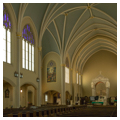You are here
St. Mary’s Cathedral
The Cathedral of the Nativity of the Blessed Virgin Mary, commonly known as St. Mary’s Cathedral, serves the western Catholic diocese of Nebraska. The present church is the culmination of several building episodes, the first originating in the late 1860s as Catholic families were beginning to move into the county. The original church was destroyed by a windstorm prior to its dedication. The small frame replacement of 1877 was followed by a brick church in 1889. The congregation soon outgrew this structure as well. When the administrative center of the diocese was transferred to Grand Island in 1917 St. Mary’s was elevated to cathedral status. Construction of the present building, designed by Brinkman and Hagan of Emporia, Kansas, was completed in 1928. Archbishops and bishops from across the country, including Patrick Cardinal Hayes of New York, attended the dedication and consecration.
St. Mary’s is a Grand Island landmark and one of the finest examples of the Gothic Revival in the state. A modified Latin cross in plan, the sandstone structure has a vertical emphasis with pointed arch openings and embellished stepped buttresses on the front, sides, and transept. The intersection of the nave and transept is crowned by a tall fleche. Large windows displaying elaborate stone tracery enliven the front facade, nave, and transept.
The interior, accommodating more than 900 people, is impressive. Soaring to a height of seventy-five feet, the nave is spanned by fan vaulting supported by clusters of engaged columns. The chancel embraces a Gothic-detailed main altar and thirty-one-foot-tall baldacchino, both of which are made of white Italian marble. Italian artisans installed the five Carrara marble side altars imported from Italy.
References
Fagler, James D., “Cathedral of the Nativity of the Blessed Virgin Mary,” Hall County, Nebraska. National Register of Historic Places Inventory–Nomination Form, 1982. National Park Service, U.S. Department of the Interior, Washington, DC.
Writing Credits
If SAH Archipedia has been useful to you, please consider supporting it.
SAH Archipedia tells the story of the United States through its buildings, landscapes, and cities. This freely available resource empowers the public with authoritative knowledge that deepens their understanding and appreciation of the built environment. But the Society of Architectural Historians, which created SAH Archipedia with University of Virginia Press, needs your support to maintain the high-caliber research, writing, photography, cartography, editing, design, and programming that make SAH Archipedia a trusted online resource available to all who value the history of place, heritage tourism, and learning.






